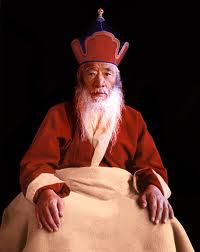DVA is the first western organization ever endorsed by Renowned Tibetan Dzogchen Master Chatral Rinpoche, who fully supports our mission in advocating for vegetarianism. Kyabje Chatral Sangye Dorje Rinpoche is one of the few living disciples of the great master Khenpo Ngagchung and is widely regarded as one of the most highly realized Dzogchen Masters. Chatral Rinpoche also studied with some of last century’s most renowned masters, including Dudjom Rinpoche, Jamyang Khyentse Chokyi Lodro, and the famed dakini Sera Khandro.
Chatral Rinpoche is the heart disciple and Vajra Regent of the late Dudjom Rinpoche and is the chief lineage holder for three main traditions in the Nyingma School: Dudjom Tersar, Sera Khandro, and Longchen Nyinthig, and, in particular, the lineage that descends through Jigme Lingpa’s heart son Jigme Gyalwe Nyugu and then on to Patrul Rinpoche.
He became the head spiritual teacher for the Regent Reting Rinpoche, the political ruler of Tibet in 1947. The huge amount of attention drawn to him through this prestigious position was a distraction from his practice, and he retreated back to the mountains where he spent the next several years in solitary meditation until he reached the highest state of realization.
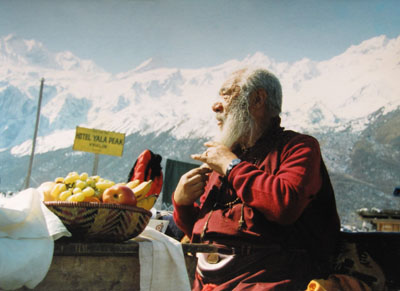 Today he stays in his own small place in Parphing, Nepal, near a sacred site of Guru Padmasambhava, who founded Buddhism in Tibet. He is married to Sangyum Kamala and has two daughters, Tara Devi and Saraswati Devi. Although he has never traveled to the West, his amazing story and teachings have gradually infiltrated Western Buddhist consciousness since Father Thomas Merton first met him in 1968 and famously remarked that he was “the greatest man I ever met.”
Today he stays in his own small place in Parphing, Nepal, near a sacred site of Guru Padmasambhava, who founded Buddhism in Tibet. He is married to Sangyum Kamala and has two daughters, Tara Devi and Saraswati Devi. Although he has never traveled to the West, his amazing story and teachings have gradually infiltrated Western Buddhist consciousness since Father Thomas Merton first met him in 1968 and famously remarked that he was “the greatest man I ever met.”
 Chatral Rinpoche is one of the most vocal opponents of meat eating in Tibetan Buddhism. During the traditional long retreat and at all of Rinpoche’s monasteries, temples, and retreat centers, only vegetarian food is served.
Chatral Rinpoche is one of the most vocal opponents of meat eating in Tibetan Buddhism. During the traditional long retreat and at all of Rinpoche’s monasteries, temples, and retreat centers, only vegetarian food is served.
Chatral Rinpoche is renowned for releasing large numbers of fishes from the Calcutta fish markets every year, as well as saving many birds and land animals from slaughter.
Dharma Voices for Animals is especially honored that Chatral Rinpoche has decided to add his voice to that of all our members since we are the first organization in the West that he has ever endorsed
 Reviewing Chatral Rinpoche’s book, Compassionate Action, Sogyal Rinpoche, author of The Tibetan Book of Living and Dying, stated:
Reviewing Chatral Rinpoche’s book, Compassionate Action, Sogyal Rinpoche, author of The Tibetan Book of Living and Dying, stated:
“Kyabje Chatral Rinpoche . . . is renowned throughout the Tibetan community, . . . a legendary adept who—like the great sages and hermits of the past—has spent much of his life in retreat, practicing meditation and granting teachings only sparingly to a few committed disciples. It is truly wonderful, therefore, that we now have this precious collection of his teachings and advice capably translated into English, enabling many more people to benefit from his boundless wisdom and compassion.”
Kyabje Chatral Sangye Dorje Rinpoche is one of the most accomplished Tibetan Buddhist yogis alive today. In 1947, he had the lofty status of being the head spiritual master of Regent Reting—the political leader of Tibet—but he has always preferred to live as a humble yogi in a simple dwelling without the distractions of fame and fortune. He practices what he preaches without compromise and as a result is beloved throughout the Himalayan region by people of all faiths.
Rinpoche was born in June of 1913 in the Nyak Adzi Valley in Kham, Tibet, to pious members of the Abse tribal group named Pema Döndrub (father) and Sönam Tso (mother). The day after Rinpoche was born, a local lama named Asey Bigo Tulku Nyima Gyaltsen came to Pema and Sonam’s house to tell them of a vision he had about Rinpoche’s emergence the day before in which a white donkey loaded down with Buddhist scriptures came to Pema and Sonam’s house and delivered the texts to them. In accordance with this vision, he bestowed the name Trogyal Dorje, which means “Adamantine Wrathful Victorious One,” to Rinpoche.
Chatral Rinpoche’s family moved to Amdo with their tribal group when he was a small child. At age 15, Rinpoche decided to leave his family in order to study and practice Buddhism with the masters of the area. This act of renunciation began his life-long journey as a carefree yogi seeking Enlightenment at any cost in order to effectively help other beings with compassion. From the onset, Rinpoche was highly principled, traveling exclusively on foot and refusing a horse when offered. He stayed only in hermitages, caves or his small tent to avoid involvement with householders and their worldly preoccupations.
Chatral Rinpoche received transmissions of the terma cycle of Terton Dudjom Lingpa (1835-1903) from the Terton’s son Dorje Dradül (1891-1959). Rinpoche would later become the Vajra Regent or Chief Lineage Holder of this cycle of teachings, known as Dudjom Tersar. Another one of Rinpoche’s main early teachers was Khandro Dewai Dorje (1899-1952), who was a daughter-in-law of Terton Dudjom Lingpa. She passed on to Rinpoche the terma cycle teachings of Sera Khandro and he became the principal lineage holder of this tradition as well.
At this time, Chatral Rinpoche met his root guru, Khenpo Ngawang Palzang (1879-1941) of Kathok Monastery. The great Khenpo had been the heart disciple of Patrul Rinpoche’s main student, Lungtok Tenpai Nyima (1829-1901), and was considered to be a manifestation of the 9th Century Dzogchen master Vimalamitra.
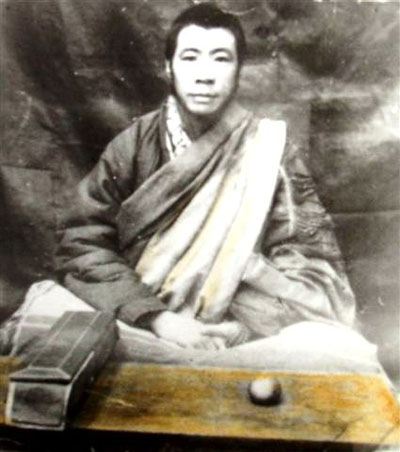
Khenpo Ngakchung gave Chatral Rinpoche many teachings and transmissions—particularly of the Longchen Nyinthig tradition—and for the next six years Rinpoche studied under him, completing his ngöndro and practicing trekchöd and tögyal, which are some of the most advanced practices of Dzogchen. Rinpoche studied with other masters at Kathok Monastery as well, in addition to the great Khyentse Chökyi Lodrö (1893-1959) from Dzongsar Monastery, which like Kathok lies in the Derge region of Kham.
Khenpo Ngawang Palzang knew Rinpoche was very special and acknowledged him to be his closest disciple, explaining that, “his mind and my mind are no different.” He bestowed upon Rinpoche the name Chatral Sangye Dorje, which means “Indestructible Buddha who has Abandoned all Mundane Activities.”
The first time Chatral Rinpoche’s greatness became revealed to others was at a large worship service at Kathok Monastery, attended by several high lamas sitting on lofty thrones. Rinpoche sat in the back on a simple meditation cushion with a few hundred other monks. Khenpo Ngawang Palzang remarked during the service:
“Among all of you here today, there are less than ten people who have one-tenth of my realization. Then, there are less than five of you who have half of my realization. Finally, there is only one person here whose realization is no different from mine, and he is Chatral Sangye Dorje. He can now represent me to transmit the teachings and his merits are the same as mine. “
This proclamation caused quite a stir in the assembly hall and afterward people came to congratulate Rinpoche. Preparations began for a grand ceremony to honor Rinpoche in his new status. Rinpoche was not one for all this attention and praise and so snuck away in the middle of the night with his tent to continue his practice alone in the wilderness. The next day when they came to honor him, they found his room empty with no trace of where he went. Once again, he lived up to his name Chatral, which can be translated as “hermit.”
Chatral Rinpoche once explained, “We abide nowhere, we possess nothing.” In the ultimate sense, this is a profound statement on the impermanence of life and emptiness of all things. In the conventional sense, this is how a yogi like Chatral Rinpoche actually lived in Tibet. Having no household or possessions to weigh on one’s mind, one is completely free to practice the Dharma. As far as the seeming adversity of physical discomforts and irregular meals, Dudjom Rinpoche explained, “When realization becomes as vast as space, all adverse conditions arise as friends.”
In 1937, the Regent-king of Tibet, Reting, who was the political leader of the country until the current Dalai Lama came of age, requested teachings from Khenpo Ngawang Palzang. Khenpo Ngakchung told him, “I am too old now for transmitting teachings to you. I have a disciple whose mind and realization is the same as mine and he is called Chatral Sangye Dorje. You can go ask him for teachings.”
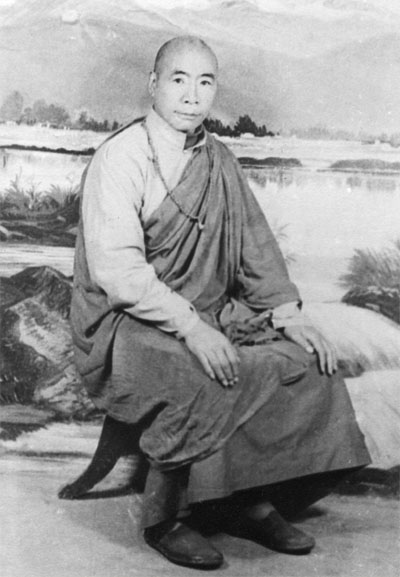
Regent Reting looked all over for Rinpoche and found him meditating in a remote mountain cave. Upon hearing his request, Rinpoche replied, “I am sorry, there is nothing special about me and I have nothing to teach you. Please go elsewhere for teachings!” The Regent then produced a letter by Khenpo Ngakchung to support his request, and so Rinpoche reluctantly agreed to go to Lhasa to teach Regent Reting.
People from all over poured into Lhasa to meet Rinpoche and get teachings and blessings from him. This included high-ranking lamas, political leaders and common laypeople, who made many offerings to Rinpoche. Naturally, he saw all of this attention as a distraction for his spiritual development. He requested to have some time to meditate in a remote area away from Lhasa. The Regent agreed and sent a large entourage of servants and guards to escort Rinpoche on his journey. After they arrived, Rinpoche asked the group of men to return to Lhasa so he could meditate in solitude. The Regent didn’t like his teacher being alone, so sent some guards back to locate Rinpoche. Along the way they found a poor beggar dressed in royal brocade robes. Chatral Rinpoche had traded his fancy outfit for beggar’s rags in true yogi style!
Another great spiritual master who came into Chatral Rinpoche’s life was Kyabje Dudjom Rinpoche, Jigdral Yeshe Dorje, who was an incarnation of Terton Dudjom Lingpa. Dudjom Rinpoche transmitted to Chatral Rinpoche the complete cycle of the Dudjom Tersar teachings, naming him the Vajra Regent of the tradition.
Chatral Rinpoche spent a great deal of his time practicing in caves blessed by Guru Padmasambhava— the founder of Tibetan Buddhism and author of the terma teachings that are the basis for many of the lineages of the Nyingma School. Chatral Rinpoche is actually considered to be the manifestation of Guru Padmasambhava’s mind, due to prophecies written about Rinpoche’s emergence and his proven wisdom.
In the late 1950’s, Chatral Rinpoche moved to Bhutan. He was not forced out by the events of March 10th, 1959, like many other Tibetans, but went to Bhutan on his own free will. This may be indicative of his being the manifestation of Guru Padmasambhava’s mind, as Guru Padmasambhava predicted that the Tibetan people would be displaced from their homeland at the advent of the modern age and Chatral Rinpoche seemed to know that the time was right for him to travel to other areas in the Himalayas. When he was asked what this trip was like for him, he smiled and replied, “Completely free, light and happy.”
He traveled to the neighboring Himalayan region of Darjeeling, where he restored a simple temple and turned it into a three-year meditation retreat center for Longchen Nyinthig practice. This was the first such center built by a Tibetan outside of Tibet. Rinpoche then went to some of the major Buddhist pilgrimage sites in India. While visiting the site of the Buddha’s Enlightenment in 1960, he made a firm commitment that would become a famous part of his identity. He said, “I went to Bodhgaya and made a vow to all the Buddhas and Bodhisattvas to give up meat and alcohol.” Rinpoche is quite unique in his intensely disciplined stance on this issue and this is part of what makes him so revered by those who know him.
A few years later, he met Kusho Kamala, daughter of Terton Tulzhok Lingpa, who became his sangyüm. They have two daughters, Saraswati and Tara Devi. Saraswati serves as his main assistant and speaks fluent English. She is considered to be an emanation of the dakini Sera Khandro.
In 1968 in Darjeeling, Chatral Rinpoche had a famous meeting with the Trappist monk Father Thomas Merton, an advanced Zen Buddhist practitioner held in high regard by other Buddhists. After the meeting, Merton was later overheard saying “That is the greatest man I ever met. He is my teacher.”
Chatral Rinpoche was relentless in his study and practice. In India, he received teachings from Kalu Rinpoche, who became his close friend, and the 16th Karmapa Rangjung Rigpe Dorje.
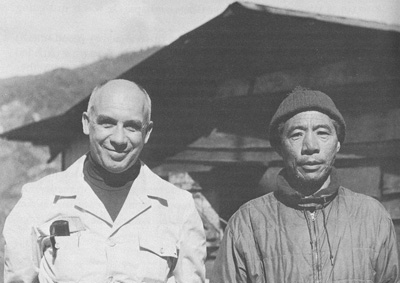
He received teachings from over one hundred masters in all, from many traditions of Tibetan Buddhism. The breadth of his scholarship is evident in his writing, as he quotes texts from a myriad of traditions to support the points he makes in his essays.
Chatral Rinpoche has founded or restored meditation retreat centers in Bhutan, India and Nepal as well as overseen the construction of several stupas. Dudjom Rinpoche consecrated Chatral Rinpoche’s center in Darjeeling in 1962 and around ten years later helped Rinpoche start a center in Yangleshöd, Nepal, which he thought would be a very auspicious place since Guru Padmasambhava did some important practices there. This monastery, which lies on the outer rim of the Kathmandu Valley and is known as Rigzin Drubpe Ghatsal, was one of Rinpoche’s primary residences for many years. Compared to many other lamas who have lavish, spacious quarters, Rinpoche’s residence here is incredibly humble and cozy.
Many thousands of people in the Himalayan region consider Rinpoche to be their root guru because through his compassionate action and profound wisdom, he is a perfect embodiment of the Buddha’s teachings. However, he is very selective about those he actually gives teachings to. He is fully aware that most of the people who ask him for teachings are not a fraction as serious about their practice as he is, so doesn’t bother to waste the precious nectar of his teachings on an unsuitable vessel. Rinpoche explains, “There are three kinds of Dharma practitioners: firstly, there are those who look like practitioners outwardly, but inwardly they are not real practitioners; secondly, there are those who talk very high, but have no realization at all; thirdly there are those who do not look like practitioners outwardly, but who are in fact genuine practitioners inside.” Rinpoche therefore will not transmit any higher-level teachings to those who have studied with him for less than six years—sufficient time for them to prove themselves as genuine practitioners.
Westerners especially are treated with suspicion. Too many come wanting the ultimate teachings of Dzogchen without being remotely qualified to receive or understand them. There is a story of a wealthy person from the United States who came to Rinpoche and set big stacks of American dollars in front of him, saying that if Rinpoche gave him Dzogchen teachings, then he would give him all of this money. Rinpoche told him briskly to take his money away and declined to give him teachings as he could sense the man was not at the proper stage to understand Dzogchen. The sacred teachings can certainly not be bribed; one must earn the right to receive them.
In the Longchen Nyinthig tradition, it is not uncommon for higher-level teachings to be passed on to only one or two of a master’s most dedicated and gifted disciples. Khenpo Ngawang Palzang’s root guru Nyoshul Lungtok transmitted some of the Longchen Nyinthig teachings and empowerments to the great Khenpo exclusively. These types of teachings are regarded as secret and are preserved by a direct one-to-one transmission from a realized master to a fully qualified disciple.
Since there are very few people qualified to receive teachings like this, Chatral Rinpoche does not spend a lot of his time giving teachings. Instead, he tirelessly engages in virtuous activity, culminating in his famous annual trip to Calcutta, India, where he frees seventy truckloads of live fish back into a part of the Indian Ocean where fishing is prohibited, praying for everyone.
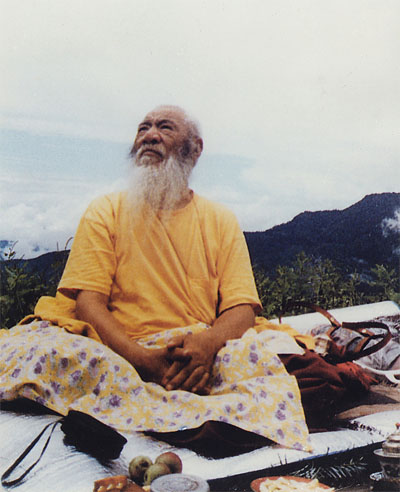
He receives donations from around the world for this great act of compassion, which is the subject of one of his essays in this book. Still, he is very supportive of serious practitioners, traveling to his different retreat centers as often as he can to check on their progress.
Chatral Rinpoche also graciously offers guidance to those from other faiths who meet with him. When an Anglican priest asked him for a teaching recently, Rinpoche said, “Just decide what is the most important thing Jesus ever said, and then take it as far as you can.” This turned out to be the most profound advice the priest had ever received and it served to deepen his understanding of Christ.
Chatral Rinpoche makes appearances to support his disciples through dreams and visions. In 1997, Lama Tharchin Rinpoche was beginning a weekend retreat in San Francisco, when he told his students that Chatral Rinpoche had appeared in a dream and asked Lama Tharchin and his students to accumulate one hundred million recitations of Guru Padmasambhava’s seven-line prayer in order to remove obstacles to Lama Tharchin’s health, to benefit all beings and help bring peace to the world during this degenerate age.
Following the Tibetan New Year in 2000, hundreds of pious Buddhists gathered at Rinpoche’s center in Yangleshöd from different parts of the Himalayan region, requesting Rinpoche’s blessings for the new millennium. They camped out in tents near his monastery and waited patiently for days. At the most auspicious time, Rinpoche gave them all a long-life initiation. After the initiation, the group sang beautiful songs praising the great activities and glory of their exalted master and danced joyfully.
Chatral Rinpoche is renowned for being incorruptible and insistent on doing things the right way. In the Tibetan Buddhist tradition, when someone dies, it is standard to leave them for three days to allow ample time for the consciousness to leave the body and hopefully enter into a Pureland realm or at least a high rebirth. According to Sogyal Rinpoche, “[Chatral Rinpoche] told people who were complaining that a corpse might smell if it was kept in hot weather [for three days]; “It’s not as though you have to eat it, or try to sell it.”
Chatral Rinpoche’s legend will undoubtedly live on for many generations. In 2003, he was honored as one of the most influential figures in Nepal during a ceremony in Kathmandu. Since Rinpoche is already fully realized, he didn’t worry about the attention and praise of this event affecting his practice this time and attended the ceremony along with many of his students and friends. Showing that he is still a carefree yogi at heart, he wore a traditional Nepali topi hat during the ceremony—likely a first for a Tibetan Buddhist master!
Despite the adulation of countless thousands in the Himalayan region, Rinpoche remains as humble as ever. He once said,
“I am just an ordinary sentient being and there is nothing special about me. I just follow the teachings of Lord Buddha. Without any cheating on my part, I stand firmly on the ground in practicing the Dharma and in helping all sentient beings. I wish that all sentient beings could let go of the acts of self-deception and self-aggrandizement, so that they can really practice the Dharma in order to liberate themselves from cyclic existence and to help other sentient beings. Otherwise, it will be too late when they are feeling remorseful!”
Benefits of Saving Lives
by Chatral Rinpoche
I bow down before the Lama, Buddha Amitayus,
And the bodhisattvas in training.
I shall now in brief describe the benefits
Of freeing animals and ransoming their lives.
To save animals from slaughter or any mortal danger,
With an entirely pure motivation and conduct,
Is without doubt a practice to be taken up
By all followers of the Buddha Shakyamuni.
Many sutras, tantras and commentaries
Describe in detail the advantages it brings,
And countless learned and accomplished masters of India and Tibet
Have stressed the value and importance of benefitting beings.
Even in the basic vehicle one avoids inflicting harm on others,
In the mahayana this is the very training of a bodhisattva,
And in the secret mantra, a principal samaya of the ratna family.
The reasoning behind this is as follows: in this world,
Nothing is as dear to someone as his or her own life,
So no greater crime is there than taking life away,
And no conditioned virtue brings greater merit
Than the act of saving beings and ransoming their lives.
Therefore, should you wish for happiness and good,
Exert yourself in this, the most supreme of paths,
Which is proven through scriptures and through reasoning,
And is free of obstacles and potential dangers.
Consider your own body and with this as an example,
Avoid doing anything that might bring harm to others.
Make every effort not to kill any living creature,
Birds, fish, deer, cattle and even tiny insects,
And strive instead to save their lives,
Offering them protection from every fear.
The benefit of doing so is beyond imagining.
This is the best practice for your own longevity,
And the greatest ritual for the living or deceased.
It is my main practice of benefiting others.
It dispels all external and internal adversity and obstacles,
Effortlessly and spontaneously, it brings favourable conditions,
And, when inspired by the noble mind of bodhichitta and
Completed with dedication and pure aspiration prayers,
It will lead one to complete enlightenment,
And the accomplishment of one’s own and others’ welfare
Of this you need to have no doubts at all!
Those whose minds incline to virtue and acts of merit,
Should prohibit hunting and fishing on their land.
Some birds, in particular, such as geese and cranes,
Are impelled by their karma to migrate
And fly south in autumn, north in spring.
At times, weary from the efforts of their flight,
Or having lost their way, some are forced to land,
Distressed, afraid and anxious; when this happens,
You should not throw stones or shoot at them,
Nor try to kill them or do them any harm,
But protect them so they may easily fly once more.
To offer care and affection to sentient beings
In desperate situations who lack protection
Brings just as much merit as the meditation
On emptiness with compassion as its core
So it has been said by glorious Lord Atisha.
Lamas, officials, monks, nuns, men and women,
In all the places over which you have control,
Exert every influence and do all within your power
To release animals and ransom their lives,
While encouraging others to do the same.
In all those places where this is done,
Sickness among people and livestock will cease,
Harvests will be plentiful and life will be long.
All will enjoy happiness and wellbeing in abundance,
And at death let go of deluded experience,
Before finding an excellent rebirth within the higher realms.
Ultimately, there is no doubt that this will lead one easily
To find the supreme and perfect state of awakening.
In response to the request of Doctor Dordrak,
Who offered a pure silk scarf and a hundred Nepali rupees,
The one called Chatral Sangye Dorje,
Who strives continuously to ransom lives,
Wrote down spontaneously whatever came to mind.
By the merit of this may all sentient beings
Come to practise enlightened actions! Mamakoling samanta!
Translated by Adam Pearcey, Rigpa Translations, 2005.

